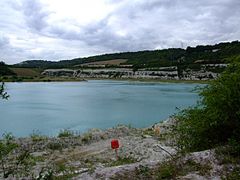Halling, Kent
| Halling | |
|---|---|
 Halling Lake |
|
| Halling shown within Kent | |
| Population | 2,821 (2011) |
| OS grid reference | TQ701642 |
| Unitary authority | |
| Ceremonial county | |
| Region | |
| Country | England |
| Sovereign state | United Kingdom |
| Post town | Rochester |
| Postcode district | ME2 1.. |
| Dialling code | 01634 |
| Police | Kent |
| Fire | Kent |
| Ambulance | South East Coast |
| EU Parliament | South East England |
| UK Parliament | |
Halling is a village on the North Downs in the northern part of Kent, England, covering 7.1 square kilometres of land. Consisting of Lower Halling, Upper Halling and North Halling, it is scattered over some 3 miles (5 km) along the River Medway parallel to the Pilgrims' Way which runs through Kent.
The origin of the name is uncertain. The following have been proposed at various times: Halls land (belonging to Hall), Heall land (from Old English, Hall Manor), Heallgemot (the court of the lord of the Manor), Heallingas (companions sharing the same hall).
"Halling Man", a Neolithic skeleton discovered in 1912 behind the present railway station, is the earliest indication of activity in Halling. There is evidence of Roman settlement indicated by a number of burials from the period as well as Roman tiles. The first written record dates from the 8th century. In the Charter for Halling (765-785 AD) Ecgberht II of Kent granted to St. Andrew of Rochester, "ten sulings at Halling with rights to pasture swine in five districts".
Halling had a small industrial presence in the eighteenth and nineteenth centuries, with two chalk mining and processing factories, however these have all now been shut and the last chimney stack was demolished in 2010.
Since before World War II, quarries have been dug in Halling, at first by hand, for the extraction of chalk for cement manufacture. The chalk was mainly shipped by barge via the River Medway.
Halling is connected with other villages and towns along the river by the Medway Valley railway line, running from Tonbridge and Maidstone to Strood. Also there are good road links as the village sits between the M20 and the M2.
The chalk quarrying industry in Halling had a great influence, including the building material of the majority of the village houses, the livelihood of many families and the improvement of its road and railway connections. However, although the area of these activities spread into what was Green Belt land, some of these areas have now reverted to the community or built upon. Parts of the village are restricted by the Green Belt regulations, limiting growth of industrial and residential areas alike.
...
Wikipedia

